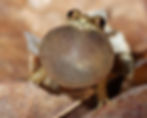Tiny Spring Peepers Create The Sounds Of Spring
- mmcmahon09
- Mar 17, 2020
- 2 min read
There are many signs that spring has sprung, and one of the loudest is a tiny little frog known as the spring peeper. This frog is very aptly named because they often begin calling early in spring, and their call sounds like a high-pitched PEEEP!

During the winter months, these frogs were practically frozen, hiding out under dead logs and piles of leaves or behind the bark in standing trees. Frogs can exchange the water in their bodies into something similar to antifreeze. Although they may appear frozen to death, they are healthily waiting for warmer weather to arrive so they can thaw out and begin their normal lives. Scientists don’t really understand how this is possible!
In early spring, the male spring peepers begin calling to find a mate. Many male peepers will sing together, often in pairs or triplets, making the sound even greater. Some say a group of peepers singing sounds like sleigh bells. It is their stretchy vocal sac that produces the sound. When singing, their vocal sac inflates to a large round ball under their chin. This sac folds up neatly under chin when they are not calling.

Scientists believe females are listening for the speed of the calls. A faster call is probably coming from an older and larger male. The females give the male of their choice a little nudge to let him know he has been chosen.
Watch and listen to a singing spring peeper:
After mating, females will lay 800 to 1,000 eggs around underwater plants. Tadpoles hatch after one or two weeks. They complete their metamorphosis from tadpole to frog in about 100 days. After one year they can mate, but they usually don’t until they are 3 years old.
The scientific name for spring peepers is Pseudacris crucifer. The crucifer in the name refers to the X, or cross shape, that is present on both the males’ and females’ backs. However, it is very rare to see this frog in the wild for a few reasons. One, these frogs are nocturnal. Also, at their largest, they are just more than 1 inch long, about the length of a paperclip! Plus, their beige color makes them blend in well with their surroundings.
Spring peepers are woodland frogs, but they also need to be near water, for laying eggs and to help keep them cool in the hot summer months.
These small frogs are true carnivores. They feast on small insects, like beetles, ants, flies and mosquitos, as well as small spiders. They also are food for many species, including larger frogs, fish, birds, skunks and snakes.
In Will County, the times these frogs start calling seems to change from year to year and may also be dependent on the specific location. They have been heard from mid-March all the way through early June, so head outside and keep your ears peeled!
____________
Follow Willy's Wilderness on Facebook for more kid-friendly nature stories and activities.




